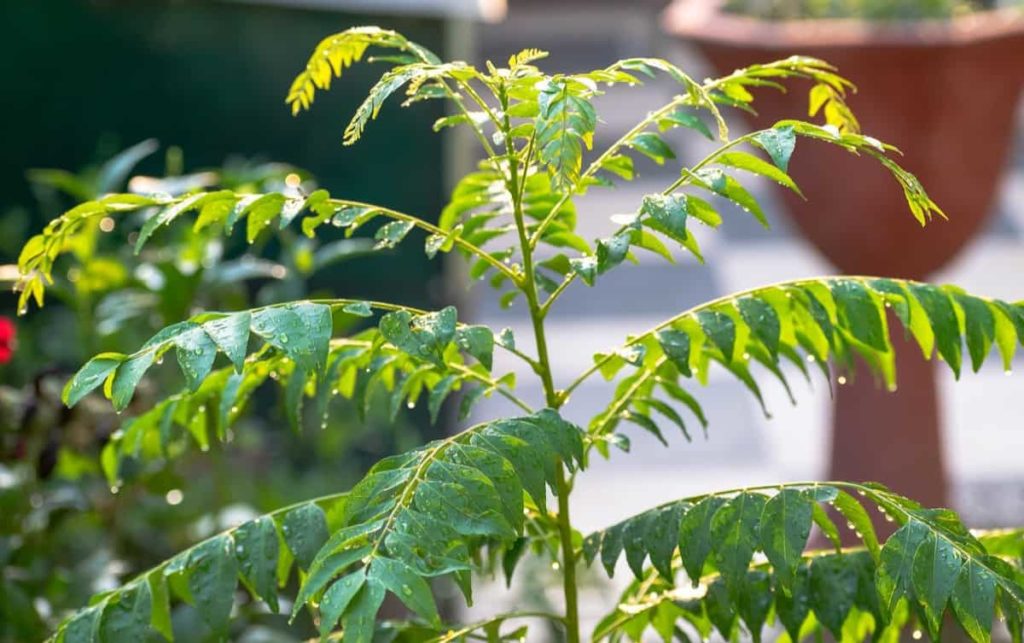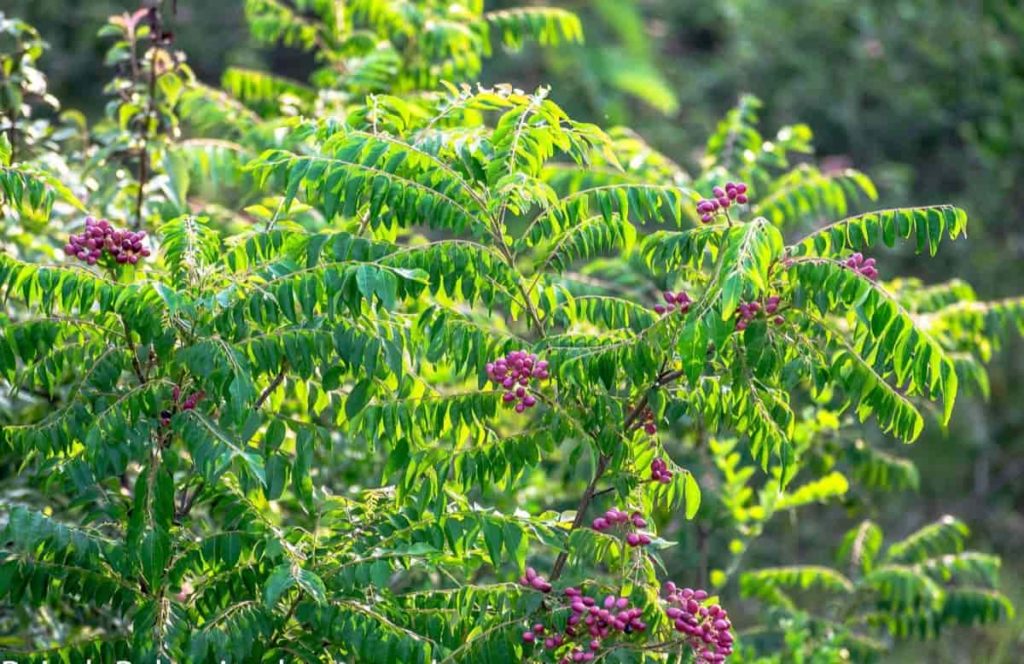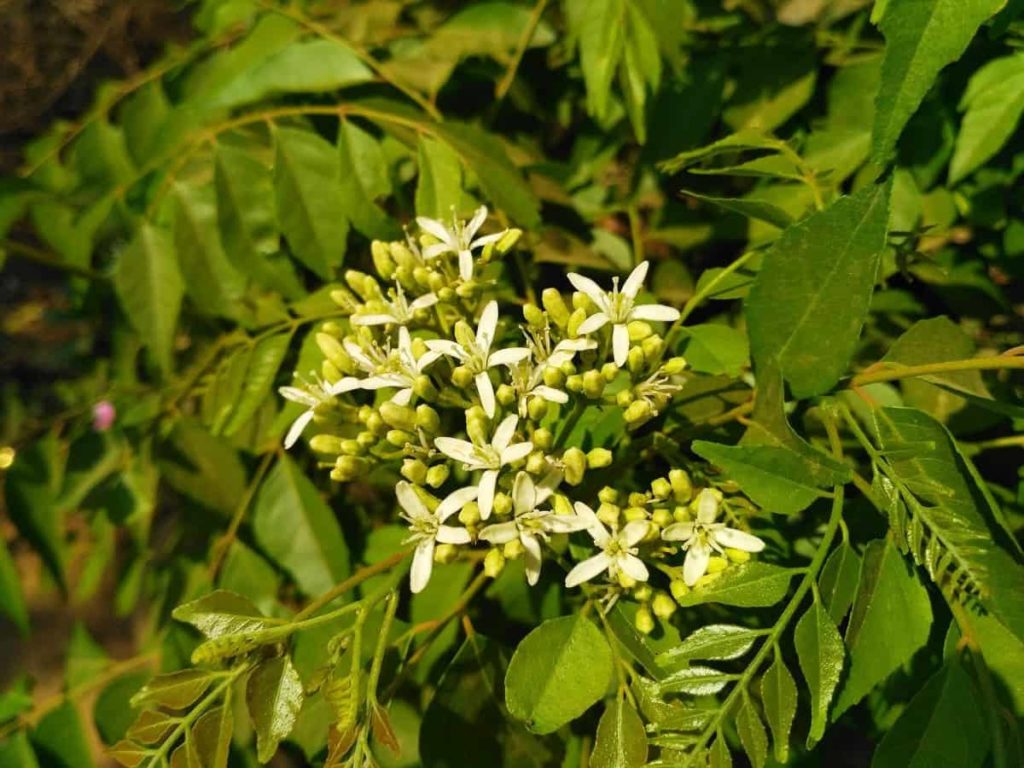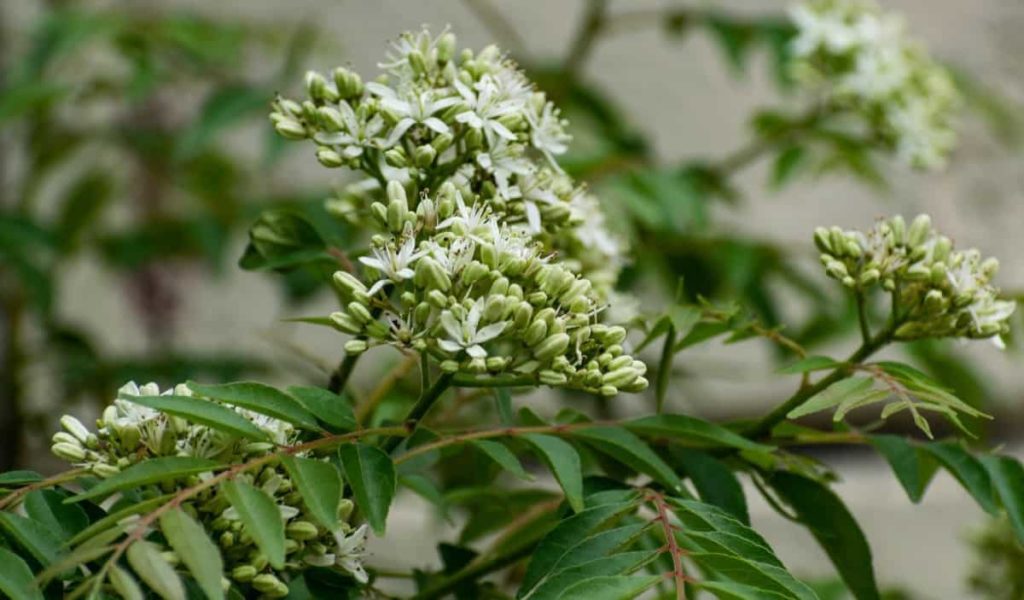Once established in ideal sunny, tropical conditions, the Curry Leaf tree is a strong plant. The Curry Leaf tree can only be grown in containers in a cold climate. Let them spend the summer outside and bring indoors after the cold weather begins. Ensure you have the proper space inside the house for overwintering the plant. The Curry Leaf plant is a rare plant that does not experience any problems with insects. It often acts as a pest deterrent due to its strong odor. Some insects, including scales, aphids, and mealybugs, can attack your plants.

Common Curry Leaf plant problems
The Curry Leaf plant is dying
If your Curry Leaf plant is dying, it is likely to suffer from hydration problems, pest attacks, soil problems, or not getting enough sunlight. You should address the dying plant as soon as possible.
Sunlight
Very little sunlight often plays an important role in why homegrown Curry Leaf plants die. These plants need daily sunlight to thrive.
Solution – If you see the Curry Leaf plant is curling down or bent, the chances are that lighting is the culprit. Try to give the plant a full day of sunlight to see if they start perking up.
Cold weather
Curry Leaf plants like to live in relatively warm environments. Remember, it is a subtropical plant with temperatures above at least 19°C. You will bring the plant indoors when the temperature falls below 5°C on any given day.
Solution – If you are trying to revive a plant suffering from cold weather, be sure to provide natural sunlight 6 to 8 hours a day should be sufficient.
Soil issues
Curry Leaf plants prefer soil that is well-drained and slightly acidic. This plant requires a good pH level from 5.5 to 6.5. It can indicate a soil problem if you see spots on your plant leaves, such as brown, or white. You can also see leaves in the plant getting yellow.
Solution -Remember that you must sometimes disturb the plant to eliminate the right problem. But it helps start with a pH test to determine if the soil is too alkaline.
In case you missed it: How to Grow Curry Leaves from Seeds at Home: Steps, and Seed Germination Process

Hydration problems
If your soil is too dry, the Curry Leaf plant will not have enough water to transfer nutrients to its branches. And if the soil is not drained properly, it can cause the roots to be buried under the weight of water, and as a result, the leaves may bend and wilt. It can also cause fungal problems like root rot in the plant.
Solution – Depending on the extent of the soil problem, you may be able to revive the plant by giving it just a little sunlight. Do this for 1 to 5 days and closely monitor the plant to improve the shape of its leaves. If you don’t see any improvement, consider replacing the soil with fresh new soil and see if it helps. You can also make a mixture including loam or sand mixtures, to help it drain better.
Pest attack
The Curry Leaf plant is prone to attack from common plant insects such as aphids, whiteflies, scales, and spider mites, especially when grown outside. When the plant is grown indoors, it can be more susceptible to whiteflies and fungus gnats.
Solution – Unfortunately, it does not have many natural predators who can control the pest population after these pests reproduce. So, the best way to eliminate them is by using pesticides.
Treat the underlying condition
The Curry leaves are yellow, brown, or wilted, indicating a fungal or water problem. It can also reveal nutrient problems that need to be addressed. Start by doing a pH test and checking the hydration level of the soil. You can stick your finger down about 2 inches in the soil for the hydration test. Soil should be loose, moist, and drained thoroughly.
Solution – Give good water to the plant and monitor it for a few days. If the soil is too moist, ensure the plant gets more sunlight daily. Also, check the environment’s temperature to ensure the plant does not cool too much. Apply a standard fungicide to the tree to eliminate it if it has a fungal infection. If a pest attack causes this problem, you must identify the type of insects and apply proper pesticides.
Brown tips on the Curry Leaves
Lack of moisture is often culprit by browning tips and edges.
Solution – Mist the leaves with water to increase moisture. The leaf should return to its normal color within a few weeks. Don’t overspray; you only want to dampen the leaves.
Peaches, Melons, and Foxglove aphids often attack Curry Leaf plants. In addition to looking for their small size, inspect the leaves for small white skins and honeydew.
Solution – Apply insecticidal soap or horticultural oil to kill the aphids. Malathion and Acephate pesticides kill many aphids but are also more toxic.
Place a white cloth or paper under the affected leaves and lightly shake the stem. The insects will fall on paper if your Curry Leaf plant is infected with thrips, which usually eat Curry Leaf plants.
Solution – Applying horticultural oil, insecticidal soap, and Spinosad for relief. Predatory insects are the natural enemy of thrips and will also take care of rapidly attacking insects. Always cut off the infected leaves, and never use persistent pesticides.
Inspect the leaves for a white matter called powdery mildew. Like many plants, powdery mildew can attack Curry Leaf plants, leading to deformed and colorless leaves. White spots are always present on infected leaves; yellow-brown spots can appear on tips and throughout the leaf body when the disease is severe.
Solution – Applying sulfur and horticultural oil fungicides before powdery mildew is present helps prevent disease. Fungicides that contain Bacillus subtilis can kill fungus after affecting the Curry Leaf plant.
In case you missed it: Curry Leaf Growing Tips, Ideas, and Secrets

Curry Leaf plant leaves curling
Pests
Pests can be a significant cause of curling. Sucking insects like aphids can promote leaf distortion and curling. They can be generally found under the leaves or towards the end. Another pest is whitefly can cause your Curry Leaf plant to be turned upwards. They stick under the leaves sucking moisture from the air.
Solution -You can eliminate pests by using pesticides sprayed on the affected area. You can use soap or water to avoid pesticides because they are too expensive. Reapply until all the aphids are killed. Removing the worst affected areas is often the best option for significant infections. However, you can avoid pest problems by using sticky traps that draw them. If you find sticky traps full of insects as a sign of a future problem rather than a complete treatment, you should inspect your plants thoroughly.
Overexposure to light
While Curry Leaf trees prefer to be in full sun, however, more exposure to light can be the cause of curling. Excessive photosynthesis has led to chemical reactions within the plant, which is the possible cause. Excessive light can cause old leaves to become curled and fresh leaves to brown and eventually die.
Solution – Curry Leaf trees may benefit from less direct sunlight, or you can place a net screen between the window and the plant to reduce brightness.
Overheating
Like too much light, too much heat is also one of the main reasons for curling your Curry Leaf plants because leaf curling is a natural response to overheating, which can contribute to rapid water loss.
Solution – You can open the window or use a fan to cool it down. Finally, don’t forget to monitor room temperature and avoid keeping plants close to heaters or light sources if you want to protect them from overheating. Furthermore, it is also important to provide sufficient space between plants for air circulation.
Transmission of the virus
If Curry Leaves curl upward, it could signify a viral infection. Removing infected plants will help prevent their spread, as most plant diseases are incurable. Infected plants are likely to show different symptoms, including leaf curl.
Solution – As soon as you remove an infected plant, it is better to properly inspect your other plants near the Curry Leaf tree for signs of disease and remove any plants that appear. Try to remove the affected parts of any plant initially that seems healthy in addition to the small area of the disease. However, you should watch for more signs of infection and take action as soon as you see them.
In case you missed it: Homemade Fertilizers For Curry Leaf Plant (Organic)

Droopy Curry Leaf plants
The possibility is that your plant is suffering from more water or very little sunlight.
Solution – To fix this, test the finger on the soil to check the dehydration level. Stop watering for several days if the soil is too moist; also, place the plant in sunny areas to help dry the soil. Finally, check the temperature of the plant environment to ensure it is above 19°C.
Curry Leaf plant shedding leaves
There could be two reasons why your Curry Leaf plant is shedding leaves. One, the plant can be in the winter in the dormancy stage and prepare for the cold season; or two, it can have a serious health problem.
Solution – However, note that it will start growing its leaves again in spring, similar to other deciduous trees. But if your Curry Leaf plant is located indoors, it can reveal a health problem. The health problem can be caused by very little sunlight, inappropriate water, or untreated fungal infections. It is better to disturb the plant’s environmental conditions to determine the cause of the leaf drop. Observe your plants for any sign of pest damage and apply the necessary control measures to minimize further damage. Also, keep your plant healthy by giving it the right conditions and proper care and maintenance.
Curry Leaf plants are not growing
Curry Leaf plants do not grow, due to their winter dormancy, low exposure to sunlight, or low temperatures. Improper soil and over or underwater are the other problems. They are usually grown slowly.
Winter dormancy
Curry Leaf plants will go into a state of relaxation in winter, commonly known as winter dormancy. The Curry Leaf plant does not get full sunlight due to winter; due to low temperature (high cooling), the big problem is for leaves. Due to excessive cold, all leaves can fall from the plant, and no leaves remain in the plant; it is one of the common things about the Curry Leaf plant in the winter.
Solution – The big thing you need to consider is reducing water to plant by the end of the winter season. Move the plant indoors; it will provide warm temperatures and enough sunlight to plant. Increase plant temperature, slow winter dormancy duration, and save Curry Leaf plants.
Low exposure to sunlight
The Curry leaves will curl down and bend if you give less sunlight.
Solution – If you are present in frozen climate conditions, you must consider giving your plant artificial white light instead of sunlight.
Soil
Curry Leaf plants need fertilizers; if you potted your plant more than four months ago, put those fertilizers even when the plant does not have leaves.
Solution – Apply fertilizers according to label instructions.
Overwater
Overwater Curry leaves are mostly suffering from root rot. Root rot will occur more often in water. Which will eventually make the plants die.
Solution – Remove the plant from the pot and clean the roots that are brown in color and rot. You should trim the damaged roots. To fix the roots, you should trim and leave the plant for a few days.
Underwater
Underwatered Curry Leaf plants look like wilted leaves, bent, yellow leaves.
Solution – Even if the leaves are yellow, you should not prune them or break them because of these leaves.
Curry leaves are turning yellow
Over or underwater
If excessive or less water is given to the tree, the leaves of the tree are likely to be yellow.
Solution – Therefore, you should take caution in the case of watering of Curry Leaf plant, so the water given to your plant is not more or less. There is a possibility that the plant will die. Always check the plant’s soil with your fingers to see if the soil is dry or wet.
In case you missed it: Growing Curry Leaf In Pots, And Containers At Home

Fertilize less or more
Tree leaves can often be yellow due to a lack of fertilizer. Excessive chemical fertilizers can cause the leaves to become yellow and burn.
Solution – If the plant has high fertilizer levels, the fertilizer in the soil should be washed with excess water. So, learn about fertilizers, and know about food for fertilizer application.
Lack of oxygen in the soil
The Curry Leaf plant can be yellow even if the soil lacks oxygen.
Solution – If there is an oxygen crisis in the soil, you should bury a few iron nails in the soil. Since nails are made of iron, the oxygen supply to the soil will increase when the nail is exposed to rust.
Potassium deficiency
The lack of potassium is characterized by a light yellowish color on the edges of the leaves. Leaf-blades are slightly dull, but the main veins are dark green. Leaves become wrinkled and broken and often die prematurely.
Solution – Excessive levels of acidity and alkalinity in the soil can lead to a deficiency of both large and minor nutrients, so check the exact pH level of the soil. Apply lime to the soil if needed to get the best benefit from the soil. Use dung manure or apply mulch to enhance organic matter in the soil. Regularly water the plants and avoid excess water.
Pest attack
As a result of the pest attack, the Curry leaves turn yellow. Aphids, spiders, and other pests attack Curry leaves.
Solution – You should take regular pesticide measures and use pesticides per requirement.
Lack of chlorophyll
In lack of chlorophyll, the leaves turn yellow. When the leaves turn yellow, the process of photosynthesis cannot produce food for the plant. Chlorophyll deficiency usually occurs when the plant leaves are deficient in magnesium, and the plant becomes completely yellow.
Solution – If the leaves are deficient in magnesium, you should use Epsom salt. You should mix 1 to 2 grams of Epsom salt in 1 liter of water and spray on leaves after 15 to 20 days.
Iron deficiency
Young leaves of Curry Leaf plants are the first to observe iron deficiency diseases. The upper leaves turn yellow, called chlorosis. But the veins of midrib and leaves remain green.
Solution – You can use green manure made from algae and nettle leaves. Applying animal manure, peat, and compost adds iron to the soil.
Pests
Mealybugs
Mealybugs are soft-bodied pests usually surrounded by a fuzz material where they roam around plants, usually on the stems.
Solution – The first step is to wash your plants to wash the insects. Then, use insecticidal soap or neem oil to eliminate them. Introducing and encouraging natural predators to prevent the attack of the Mealybugs.
In case you missed it: Growing Curry Leaves in Backyard (Kadi Patta)

Scale insects
Scale insects suck the sap from the plant, which weakens it and can lead to death if left unchecked. Symptoms of these insects include the presence of honeydew, small yellow spots on leaves, dropping leaves and branches, and sooty mold.
Solution – Check every part of each plant, mainly under the leaves. You can manually scrape off scales from the plant. Cut off the infected plant’s parts to control the damage spread. Continue observing your plant and check whether the insects are completely gone after a few days.
Whiteflies
Whiteflies are small insects that suck their sap on Curry Leaf trees and other plant leaves, often causing leaves to wilt and fall. They thrive in hot areas, and both nymphs and adult stages of these insects can damage plants. These insects also release honeydew, which attracts sooty mold and other fungi.
Solution – If you see that your plant has whitefly, cut the affected parts immediately to avoid further attack. You can also use insecticidal soaps, neem oil, aluminum mulch, and sticky traps to control these insects. If the attack is mild, you may also be able to remove the insects manually.
Aphids
Check the leaves’ backside for aphids that look smaller than 1/8 inches. Ants can also be present due to honeydew. Not properly grown due to the production of honeydew on Curry leaves and lead to the brown or yellow color of leaf tips.
Solution – Apply insecticidal soap or horticultural oil to kill them.
Diseases
Powdery Mildew
Powdery mildew mainly affects the leaves of the plant, which produces white spots with a powdery form.
Solution – Use fungicides to try to rid your plant of fungus. If it is ineffective, you may have to destroy the plant as the disease can easily spread to other plants and is likely to kill the host plant.
Leaf Spot
A leaf spot disease looks like spots on plant leaves caused by bacteria or fungus, often carried by insects such as aphids. These spots can grow together and cause the leaves to die off.
Solution – You can spray plants with a 1:10 combination of baking soda and water. You can also apply neem oil. Apply fungicides when the first sign of the disease you observe. It will not cure it, but it will prevent spores from growing.
Conclusion
If you are first growing a Curry Leaf plant, monitor closely for the first two to three months. This will help you understand what the plant responds well to and what can be potentially harmful. Also, if you suspect the plant is suffering from environmental problems, always use moderation when changing your environment. Thus, the plant will not shock as it adapts to changes.
- How to Grow Hibiscus from Flower
- Plantation Ideas for Home Decoration: A Beginners Guide
- Flower Garden Designs and Layouts for Beginners
- Planting and Spacing Techniques in Papaya: A Beginner’s Guide
- Growing Gold: Essential Techniques for Planting Pineapples
- How to Make Kalanchoe Plant Bushy: Home Remedies and Solutions
- 11 Reasons Why Your Gardenia is Not Blooming: Home Remedies and Solutions
- Eco Elegance: The Guide to Designing a Drought-Tolerant Landscape
- Gardening on a Slope: Strategies for Hillside Landscaping
- Nourish and Flourish: Top Organic Mulches for Thriving House Plants
- Everything You Want to Know about Indian Mogra Flower: Discover Uses and Growing
- Green Thumb Success: Expert Tips for Cultivating Greenhouse Pumpkins All Year Round
- Maximize Growth & Flavor: The Ultimate Guide to Companion Planting in Herb Gardens
- How to Control Rhododendron Problems Naturally: Home Remedies and Organic Ways to Fix Them
- Natural Magic: The Remarkable Benefits of Cinnamon for Plants
- Best Steps to Revive Dying Tulip with Natural and Organic Treatment
- 10 Reasons Why Your Angel Trumpet is Not Blooming: Remedies and Treatment
- How to Fix Periwinkle Leaf and Flower-Related Problems: Natural Remedies and Solutions
- How to Fix Zinnias Leaf and Flower Problems: Discover Natural and Home Remedies
- Organic Steps to Induce Lemon Tree Flowers: A Comprehensive Guide
- Bloom Booster: Crafting the Perfect Homemade Bougainvillea Fertilizer
- Optimizing Growth: A Guide to Applying NPK Fertilizer for Potted Plants
- 10 Best Homemade Fertilizers for Rubber Plant: DIY Recipes and Application Method
- How to Boost Female Pumpkin Flowers: Effective Steps for More Flowers and High Yields
- Transform Your Indoor Garden: Top Benefits of Pink Salt for Houseplants
- 10 Best Homemade Fertilizers for Peacock Plants (Calathea): Easy DIY Guide
- Unlock Blooms: 9 Reasons Why Your Potted Chrysanthemum is Not Blooming
- 8 Reasons Why Your Potted Hibiscus is Not Blooming: Fix it with Simple Solutions
- Unlock Blooms: 9 Key Reasons Your Potted Frangipani Won’t Flower
- 10 Reasons Why Is My Ice Plant Not Blooming: Remedies and Treatment
- 10 Reasons Why My Potted Hydrangea Not Blooming: Treatment and Remedies
- 10 Reasons Why is My Wisteria Not Blooming: Remedies and Treatment
- 10 Reasons Why is My Goldfish Plant Not Blooming: Remedies and Treatment
- Maximize Your Space: Ultimate Guide to Balcony Gardening with Grow Bags
- 10 Reasons Why Your Iris is Not Blooming: Remedies and Treatment
- 10 Reasons Why Your Anthurium Plant is Not Blooming: Treatment and Remedies
Hi Jagdish, I have a couple of starter trees in pots which I keep on my balcony in Queensland Australia. They get quite a bit of direct sunlight, and have not been cold at night, nor overwatered. Recently I’ve noticed tiny white spots on all the leaves, and can’t figure out what the cause is. The white spots don’t rub off (not powdery mould), and there don’t appear to be other pests on them. I’ve checked the pH – is 6.5 (fairly normal). Repotted 2 months ago and fertilised once since.
Any thoughts on what this is? Wonder if you’ve seen this before??? Love to have them grow into full trees at some point.
Regards, Mark.
Hi
I live in Southern California. I have a big curry leaves tree. All of a sudden I see it dying. Any help please.